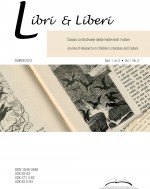
In Quest for a Tale
U potrazi za pričom
A review of Brešić, Vinko, ed. 2011. Pjesme i priče. Sabrana djela Ivane Brlić-Mažuranić [Poems and Stories. Collected Works of Ivana Brlić-Mažuranić].
More...
A review of Brešić, Vinko, ed. 2011. Pjesme i priče. Sabrana djela Ivane Brlić-Mažuranić [Poems and Stories. Collected Works of Ivana Brlić-Mažuranić].
More...
Keywords: Jacob and Wilhelm Grimm; Kinder- und Hausmärchen; narrative genre; didactic tale; formula tale; tall tale
The aim of the paper is to provide an alternative view of the Grimms’ Kinder- und Hausmärchen [Children and Household Tales], often erroneously considered to be a collection of fairy tales. Three genres have been selected as concrete case studies: didactic tales, formula tales, and tall tales. By providing both close readings of individual tales, and comparative readings of selected groups of tales, the paper aims to demonstrate how different criteria may be taken into consideration when classifying tales according to genre. A brief discussion of some of the problems concerning genre classification is followed by separate examinations and discussions of didactic tales, formula tales, and tall tales, as well as their respective sub-types. Most of the selected examples from the Grimms’ collection demonstrate a tendency to borrow and mix (genre-specific) narrative elements, which simply goes to show that the notion of ‘pure’ genre is a false one, and that genre classification still requires much scholarly attention.
More...
A report on conference "Children’s and Young Adult Literature in the Process of Media Convergence" held in Kronberg in Taurus, Germany, 17-19 May 2012.
More...
An interview with Joza Skok, a Croatian literary critic and historian.
More...
A review of Bettina Kümmerling-Meibauer's book "Emergent Literacy: Children’s books from 0 to 3" (2011).
More...
A review of Vladimira Velicki's & Ivanka Katarincic's book "Stihovi u pokretu: malešnice i igre prstima kao poticaj za govor" [Verses in Motion: Nursery Rhymes as the Encouragement for Speech] (2011).
More...
A report on the Project ART@muse.
More...
A review of Marcel Cukli's, Borivoj Dovnikovic's & Mladen Bjazic's book "Izgubljeni svijet" [The Lost World] (2011).
More...


Keywords: the abject; children’s fantasy; grotesque; monstrous-feminine; stereotypes
This paper examines the representation of female antagonists in three popular children’s books – C. S. Lewis’s Narnia books, Roald Dahl’s The Witches, and Philip Pullman’s The Amber Spyglass – by referencing Kristeva’s theory of abjection and Creed’s discussion of the monstrous-feminine. In both the Narnia series and The Witches, female antagonists are simplified, stereotyped and negatively portrayed as evil figures that threaten the stability of a well-ordered community. They are represented as the abject that blurs the borderlines between life and death, human and non-human, masculine and feminine. At the end of both narratives, the monstrous-feminine is ejected, eliminated, and the ‘purification’ brings relief and a vengeful pleasure. In Pullman’s book, the harpies are represented as monsters that can be reasoned with. They are honoured as generous and “Gracious Wings”. Yet, while the attempt of positive reinvention of the monstrous-feminine is noticeable, they play only a secondary role acknowledged by the symbolic order – the monstrous-feminine stereotype is nevertheless perpetuated.
More...
Keywords: Jacob and Wilhelm Grimm; Children and Household Tales; Croatia; Croatian children’s literature; cultural history; folk literature; history of translation; anonymity
The paper deals with the prompt, intense, diverse, and contradictory Croatian reception of the lives and works of Jacob and Wilhelm Grimm. After a short overview of early nineteenth-century references to the Grimms in Croatian daily newspapers, cultural magazines and professional and academic journals, the paper focuses on the history of Croatian translations and adaptations of their tales. The prompt reception of the brothers’ work in the field of nineteenth-century Croatian scholarship, politics, and culture is juxtaposed to the relatively delayed appearances of the translations and adaptations of their tales, Besides, even when published, the Croatian versions were hardly ever attributed to the Grimms prior to the early twentieth century. During the second half of the nineteenth century, individual tales were translated, adapted and published in Croatian children’s magazines and books of stories almost a hundred times, with virtually no references to the brothers (there is only one exception) or to their original collection. The paper presents the first Croatian appearances of tales that can be traced to the Grimms’ original work, Kinder- und Hausmärchen, i.e. the nineteenth-century Croatian translations or adaptations of individual tales which were mostly not attributed to the Grimms, but rather presented as stories, anonymous tales or vernacular (Croatian, Slavic, etc.) folktales. These adaptations and retellings are considered from the perspective of a complex relationship between cultures, literatures, and translation practices, particularly with reference to the ideas of original work, authorship and anonymity.
More...
The first Croatian translations of the works of the Brothers Grimm.
More...
A review of the book "Contemporary Children’s Literature and Film: Engaging with Theory", Kerry Mallan's & Clare Bradford, eds. (2011).
More...
A review of Darja Mazi-Leskovar's book "Young Adult Fiction on both Sides of the Atlantic" ( Mladinska proza na tej in oni strani Atlantika ).
More...
A review of Sandra L. Beckett's book "Crossover Picturebooks: A Genre for All Ages" (2012).
More...
Keywords: literature; children’s literature; social justice; upstander; classroom activities; democratic classroom; empowerment
This paper is based upon the notions that literature provides many avenues to create powerful discussions with our students, and that stories are excellent vehicles for advancing critical thoughts and eventually creating action. It also relies upon the insight that encouraging our students to speak up and speak out is a significant goal in our new international era of civic interest. Several books are discussed that are excellent examples of stories that can encourage the reader to take a stand and behave like an ’upstander’. Two classroom activities are described; Town Hall Meeting and Constructed Controversy. It is shown how they can be applied with books by Frank Asch, Sam Swope, Paul Fleischman and Martin Waddell.
More...
A report on the The Grimm Brothers Today: Kinder- und Hausmärchen and its Legacy, 200 Years After symposium held in Lisabon, Portugal, 21-23 June 2012.
More...
Keywords: bosnia; war; crimes; victims; women; russia; putin; rpr-parnas; opposition; antelopes; saiga; kosovo; Agency of Privatisation; dino asanaj; death; tajikistan; islam; muslims; marriages; temporary; poaching; central asia; kazakhstan
Plus, poachers kill dozens of rare saiga antelopes in Kazakhstan and Bosnian court hands down long sentences in war crimes case. Around the Bloc is TOL's daily digest of the important, the trivial, the tragic, the weird, and the sober from its coverage region.
More...
Keywords: Czech Republic; David Rath; racial problems; smog; unemployment; funding scandal; corruption; ROP Severozapad; Jiří Šulc; Civic Democratic Party; Eu; OLAF
"Three out of five managers of Czech SMEs believe it is impossible to win a public contract without resorting to bribery, a kickback or some other ‘incentive.' "
More...